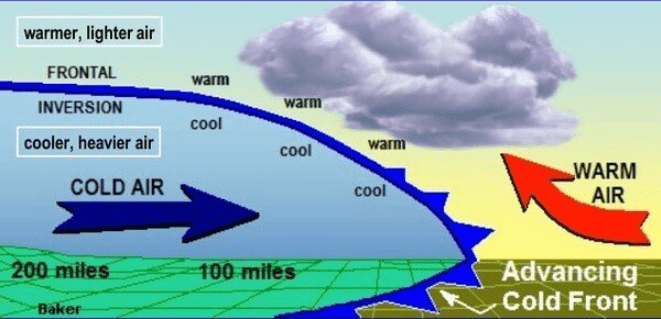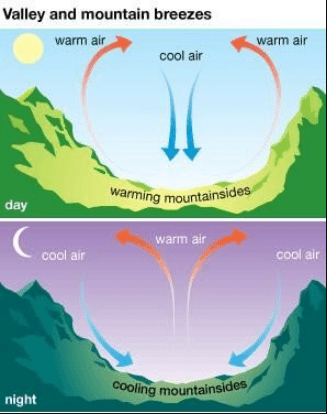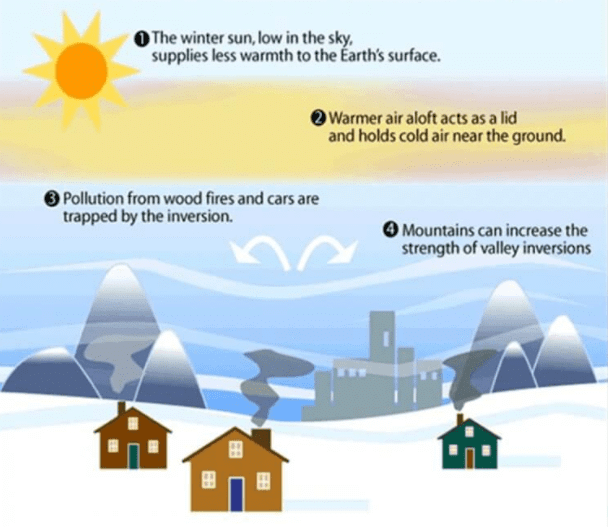Atmospheric Stability & Instability | Geography Optional for UPSC (Notes) PDF Download
Typically, the temperature in the troposphere decreases as altitude increases, with a normal lapse rate of 1 degree for every 165 meters. This is the usual pattern of temperature change in the atmosphere. However, in some instances, this pattern can reverse, causing the temperature to increase with height instead of decreasing. This phenomenon is known as temperature inversion.
The environmental lapse rate, or the rate at which temperature changes with altitude, can vary depending on location and time, particularly in the lowest few hundred meters of the troposphere. On average, the temperature change is approximately 6.5°C per 1000 meters (or 3.6°F per 1000 feet). This average rate is referred to as the average lapse rate or the average vertical temperature gradient within the troposphere.
 Temperature Inversion
Temperature Inversion
The average lapse rate indicates that for every 1000 meters increase in altitude, the temperature typically decreases by 6.5°C. Conversely, if we measure the temperature 1000 meters below a previous point, it will be about 6.5°C warmer.
A temperature inversion, also known as thermal inversion, occurs when the usual pattern of temperature decrease with increasing altitude is reversed. In other words, instead of the temperature dropping as we move higher up in the troposphere, it actually increases. This results in a layer of warm air settled above a layer of colder air. Temperature inversion is also referred to as a negative lapse rate because it goes against the expected temperature behavior in the atmosphere.
There are several factors that can cause temperature inversion, such as stable atmospheric conditions or the horizontal or vertical movement of air. Although temperature inversions are generally short-lived, they are fairly common occurrences in meteorology.
Effects of Temperature Inversion
Temperature inversion can have several negative effects on society and the economy in regions where it occurs. Some of the primary consequences of temperature inversion are:- Formation of fog: Temperature inversion can lead to the development of fog, which is essentially a cloud in contact with the ground. Visibility is typically reduced to less than 1 km in such conditions. In urban areas, fog can mix with smoke to create smog, which is a health hazard. Fog can harm crops, while smog can cause respiratory issues like asthma and bronchitis. In 1952, around 4,000 people died from smog in London. Breathing problems are common during the winter season in cities like Delhi and other major cities in northern India.
- Increased road accidents: Visibility can be significantly reduced during temperature inversion due to the accumulation of dust and smoke particles. As a result, there is an increased frequency of road, rail, and air accidents. Trains and flights are often delayed due to poor visibility.
- Crop damage: Winter crops, such as wheat, barley, mustard, vegetables, chilies, and potatoes, can be severely affected by temperature inversion. In the northern plains of India, sugarcane crops can develop a red rot disease, which reduces their sugar content.
- Impact on vegetation: Temperature inversion can also impact orchards and other vegetation. For example, the lower valleys of the Alps Mountains have very few settlements, while the upper slopes are inhabited.
- Cloud formation: In areas with a pronounced low-level inversion, convective clouds cannot grow tall enough to produce showers.
- Diurnal temperature variations: Temperature inversion can also influence diurnal temperature variations, which tend to be minimal in such conditions.
The ideal conditions for temperature inversion include long nights, clear skies, and calm, stable air. These conditions allow for greater outgoing radiation than incoming radiation, unobstructed escape of radiation, and minimal vertical mixing at lower levels.
Types of Temperature Inversion
- Frontal inversion
- Temperature Inversion in Intermontane Valley
- Ground Inversion
- Subsidence Inversion
- Marine Inversion
1. Frontal inversion
- Temperature inversion in temperate cyclones occurs due to the horizontal and vertical movement of air. These cyclones are created when warm westerly winds and cold polar air converge, resulting in warm air being positioned above cold air. This arrangement reverses the typical lapse rate, causing an inversion of temperature.
- In comparison to other inversions that are almost horizontal, this type of inversion has a significant slope. Additionally, humidity levels can be high, and clouds may form right above the inversion layer. However, this kind of inversion is unstable and will dissipate as weather conditions change.
 Frontal Inversion
Frontal Inversion
2. Temperature Inversion in Intermontane Valley (Air Drainage Type of Inversion)
- In some instances, the temperature in the lower layers of the atmosphere increases instead of decreasing as elevation rises. This phenomenon typically occurs along a sloped surface. During this process, the surface quickly radiates heat back into space, causing it to cool down faster than the layers of air above it. As a result, the lower, colder air layers become denser and heavier.
- Due to the sloping surface, this denser, colder air moves downward and settles at the bottom, forming a zone of low temperature. Meanwhile, the upper layers of air remain relatively warmer. This reversal of the typical vertical temperature distribution is known as Temperature Inversion, as the temperature profile becomes inverted.
- Temperature Inversion is particularly strong in middle and high latitudes and can also be pronounced in regions with tall mountains or deep valleys.

A ground inversion occurs when the air near the Earth's surface becomes cooler than the air above it, usually as a result of contact with a colder surface. This phenomenon is most commonly observed on clear nights when the ground loses heat rapidly through radiation, causing the surface air temperature to drop below its dew point and potentially leading to fog formation.
Ground inversions are particularly prevalent in higher latitude regions, while they can also be observed in lower and middle latitudes during cold nights. However, in these areas, the inversion typically dissipates with the sunrise. As one moves towards the poles, the duration and height of the surface inversion increase.
There are several conditions necessary for the formation of a ground surface inversion:
- Long winter nights with clear and calm skies
- Dry air and low relative humidity
- A calm atmosphere or slow-moving air
- A snow-covered surface
In summary, a ground inversion is a temperature inversion that develops when the air near the ground becomes cooler than the air above it, often on clear and cold nights. This phenomenon is more common in higher latitudes and requires specific conditions, such as clear skies, dry air, and slow-moving air, to occur.
 Ground Inversion
Ground Inversion
4. Subsidence Inversion (Upper Surface Temperature Inversion)
- A subsidence inversion occurs when a widespread layer of air descends in the atmosphere. As this layer descends, it becomes compressed and heated due to the increased atmospheric pressure. This process causes the temperature lapse rate, or the rate at which temperature decreases with altitude, to decrease as well.
- When the air mass sinks low enough, the air at higher altitudes becomes warmer than the air at lower altitudes, creating a temperature inversion.
- Subsidence inversions are commonly found over the northern continents during winter, when the atmosphere is dry, and over subtropical oceans. These areas typically experience subsiding air because they are situated under large high-pressure centers.
- The temperature inversion that occurs in these situations is referred to as an upper surface temperature inversion, as it takes place in the upper parts of the atmosphere.
5. Marine Inversion
- Marine inversions occur when cool, moist air from the ocean is blown onto the land by prevailing westerly winds. Due to the cool temperature of this air, it becomes denser and easily flows beneath the warmer, drier air present over land.
- These inversions typically happen in areas close to large bodies of water, particularly during springtime when the water is at its coldest.
- As the air passes over the water, it cools down due to heat conduction from the air to the water. This cold air is then pushed inland, flowing underneath the warmer air over the land, resulting in a marine inversion.
 Marine Inversion
Marine Inversion
Economic Implications of Temperature Inversion
- Sometimes, the air temperature in the bottom of valleys drops below freezing, while the air at higher altitudes remains relatively warm. This causes frost to form on trees along the lower slopes, while trees at higher levels remain unaffected. The inversion of temperature also leads to air pollutants, such as dust particles and smoke, being trapped in the valley bottoms, as they do not disperse properly.
- These factors contribute to the preference of building houses and farms on the upper slopes of intermontane valleys, as it helps avoid the cold and foggy conditions in the valley bottoms. For example, coffee growers in Brazil and apple growers and hotel owners in the mountain states of the Himalayas in India prefer to avoid the lower slopes for these reasons.
- Fog can also have negative impacts on both vegetation and human settlements, as it reduces visibility. Additionally, the stable conditions caused by temperature inversion can lead to less rainfall in these areas.
Conclusion
Temperature inversion is a phenomenon where the typical pattern of temperature decrease with increasing altitude reverses, leading to warmer air above colder air. This can result in fog, reduced visibility, crop damage, and impacts on vegetation. There are various types of temperature inversions, such as frontal, intermontane valley, ground, subsidence, and marine inversions. These inversions can have significant economic implications, particularly in agriculture and human settlements, as they influence the preference for building houses and farms at certain elevations and can affect crop growth and overall weather conditions.Frequently Asked Questions (FAQs) of Atmospheric Stability & Instability
What is temperature inversion?
Temperature inversion, also known as thermal inversion, occurs when the usual pattern of temperature decrease with increasing altitude is reversed. Instead of the temperature dropping as we move higher up in the troposphere, it actually increases, resulting in a layer of warm air settled above a layer of colder air.
What causes temperature inversion?
There are several factors that can cause temperature inversion, such as stable atmospheric conditions or the horizontal or vertical movement of air. Some types of temperature inversions include frontal inversion, temperature inversion in intermontane valleys, ground inversion, subsidence inversion, and marine inversion.
What are the effects of temperature inversion on the environment?
Temperature inversion can have several negative effects on society and the economy in regions where it occurs. Some of the primary consequences of temperature inversion are the formation of fog, increased road accidents, crop damage, impact on vegetation, cloud formation, and altered diurnal temperature variations.
How does temperature inversion affect air quality?
Temperature inversion can lead to the trapping of air pollutants, such as dust particles and smoke, in the lower layers of the atmosphere. This is because the stable conditions created by the inversion prevent these pollutants from dispersing properly, leading to poor air quality and potential health hazards.
Can temperature inversion be a factor in climate change?
While temperature inversion is not a direct cause of climate change, it can contribute to the impacts of climate change by exacerbating poor air quality and altering local weather patterns. Additionally, the stable conditions caused by temperature inversion can lead to less rainfall in certain areas, which can have implications for agriculture and water resources.
|
191 videos|373 docs|118 tests
|
FAQs on Atmospheric Stability & Instability - Geography Optional for UPSC (Notes)
| 1. What is temperature inversion? |  |
| 2. What are the effects of temperature inversion? |  |
| 3. What are the types of temperature inversion? |  |
| 4. What are the economic implications of temperature inversion? |  |
| 5. How does temperature inversion impact atmospheric stability and instability? |  |
|
191 videos|373 docs|118 tests
|

|
Explore Courses for UPSC exam
|

|

















